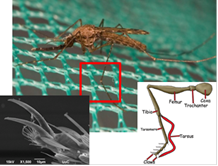All Science News

The Achilles’ heel of malaria vectors: novel insecticide resistance mechanisms expressed in their legs
Malaria has halved since 2000 (approximately 500,000 lives saved every year), with 80% of the reduction attributable to the use of insecticides. However, insecticide resistance is at a critical tipping point in public health, with some mosquito populations showing resistance to all insecticides and the strength and impact of this resistance is escalating every year. As a result, for the first time after many years, malaria cases were increased in several places after 2015, despite the far more intense use of insecticides.
The Molecular Entomology group at the Institute of Molecular Biology and Biotechnology of FORTH (FORTH-IMBB), led by John Vontas, also Professor at the Agricultural University of Athens, in close collaboration with researchers at the Liverpool School of Tropical Medicine revealed novel insecticide resistance mechanisms expressed in mosquito legs, the most relevant insect tissue for contact insecticide uptake.
Modification of epicuticular hydrocarbons and remodeling of leg cuticles, as well as the overexpression of leg-enriched sensory appendage proteins (SAP2) confers pyrethroid resistance in Anopheles gambiae. SAP2 expression is elevated in insecticide-resistant populations and is further induced upon mosquito contact with pyrethroids. SAP2 silencing fully restores mosquito mortality, whilst its overexpression results in increased resistance, likely due to the high-affinity SAP2 binding to pyrethroid insecticides. Mining of genome sequence data reveals a selective sweep near the SAP2 locus in three West African countries, with the observed increase in haplotype associated SNPs mirroring increasing resistance reported in Burkina Faso.
These studies identify new insecticide resistance mechanisms that are highly relevant to malaria control efforts and they are published in the prestigious journals Proceedings of the Royal Society B, and Nature.
“It is a highly innovative and very important research for public health, which elucidates insecticide resistance mechanisms in the major malaria vector. It promotes the international recognition of FORTH-IMBB and significantly contributes to the establishment of excellence in the field of vector borne disease”, Dr. Iannis Talianidis, the Director of IMBB, and Professor Nektarios Tavernarakis, chairman of the Board at FORTH, said.
FORTH-IMBB participates in major vector borne disease research programs, funded by the Horizon 2020 EU frame (DMC-MALVEC καιINFRAVEC2).

Figure 1. Insecticide resistant Anopheles gambiae "walking apathetic" on impregnated bednets. Modification of epicuticular hydrocarbons and remodeling of leg cuticles, as well as the overexpression of leg-enriched sensory appendage proteins (SAP2) confers pyrethroid resistance, by sequestering and substantially delaying insecticide uptake, giving time to detoxification mechanisms to detoxify them, thus producing striking insecticide resistance phenotypes.








